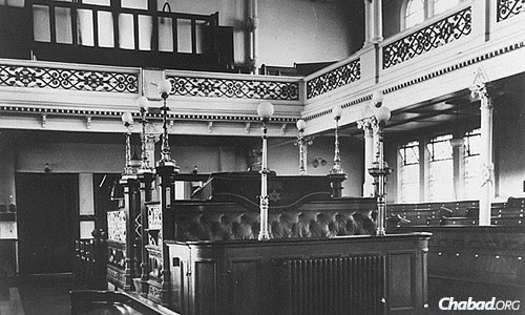
Rabbi Works for Public Nod to a Historic London Shul
The North London Synagogue opened its doors in 1868 and closed them for the last time in 1958—its fate largely reflecting the rise and fall of Jewish life in the Borough of Islington, a mainly residential district of Greater London, England.
Formerly a prosperous alternative for Jews fleeing the poverty-stricken East End in the mid-19th century, the community flourished and commissioned the richly appointed synagogue with marble, plaster molded into the shape of plants, coffered ceilings and stained-glass windows.
As the decades passed, the Jewish community dwindled. Following World War II, the synagogue, which had sustained significant damage from German bombings, ceased to function, with its former members having moved farther west to new suburbs such as Hampstead and Golders Green.
Yet one dedicated husband-and-wife team is working hard rebuild the borough’s unique Jewish community. “There are probably around 5,000 Jewish people living in Islington,” estimates Rabbi Mendy Korer, who has been living in the area with his wife, Hadasa, and their three young daughters since 2011. “Our Chabad center—Chabad-Lubavitch of Islington—is the only Jewish organization in the area. Most of the Jews here are young people who are looking for Jewish identity. It’s a very diverse place that has a very ‘living in London’ feel.”
Since their arrival, the Korers have hosted many communal events that have attracted a growing number of people, who find a place for themselves in the heterogeneous and welcoming community.
“I grew up in the south of the England in a place where there was no Jewish community,” explains 29-year-old Gilles ben Avraham. “I think that there are many other people like me. Lots of my friends identify as Jewish, but come from families that are secular or of mixed heritage.”
Ben Avraham—who works in theater—originally met Rabbi Korer at an outdoor tefillin stand, where the rabbi was offering Jewish passersby the opportunity to don the black boxes and recite a short prayer. Since their original meeting, he has been a frequent guest at the Korers’ Shabbat table and at other events.
“Mendy has been terrific,” he notes. “Any questions I ask, he is forthcoming with an answer. I’m happy to have met someone who is such a fountain of knowledge and so happy to share.”
Voting for a Plaque
On the Shabbat morning of June 28, the rebounding community celebrated a double milestone. They welcomed a brand-new Torah scroll that was generously loaned to the community, and Ben Avraham celebrated a belated bar mitzvah.
“I will remember the moment for a very long time,” he says. “With the rabbi’s help, I read from the scroll. The letters were so shiny and new. It was really amazing. I felt very blessed and happy to have the opportunity.”
He also chose a Hebrew name: Dror, meaning “freedom.” While his family didn’t come for the bar mitzvah, he says they were very happy for him.
As Korer’s new community takes root, the rabbi is campaigning that Islingon’s rich Jewish past not be forgotten. More than 50 years after the beautifully designed North London Synagogue was demolished—subsidised housing has taken its place—he is spearheading a drive to have the site on Lofting Road marked with its own Islington People’s Plaque. The plaques celebrate significant people, places and events in the borough.
So far, from dozens of applicants, the synagogue has been short-listed with nine other nominations slated for an online vote. The three locations that receive the most votes will be awarded a plaque.
“This is important for the broader population,” stresses the rabbi. “The Jewish community was the first significant migrant community to live in Islington, and it’s fitting that there be a display of this historical community currently in the borough.”
Information about the people and places nominated is available online at: www.islington.gov.uk/peoplesplaque. Voting ends at midnight on Thursday, July 31. To vote for the North London Synagogue, click here.











